Conservation Conversations: Howling for Red Wolves
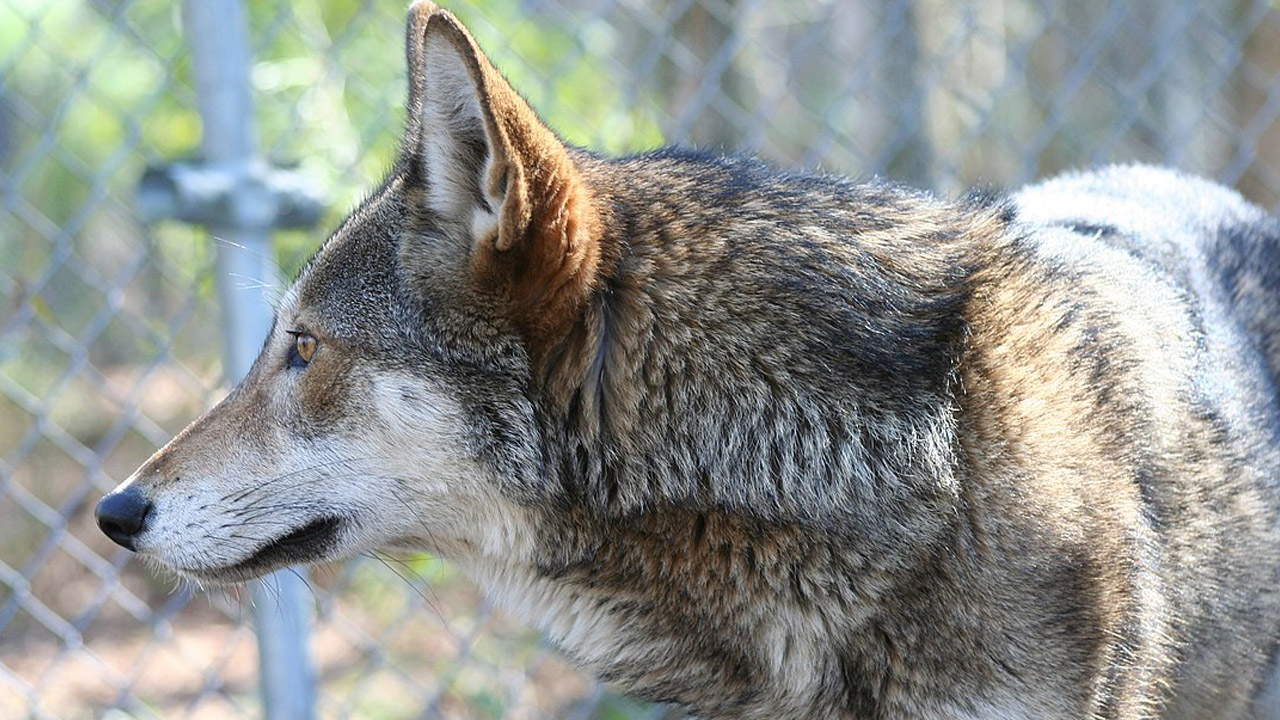
American red wolves (Canis rufus) once roamed most of the eastern half of the United States, but their populations declined due to hunting and habitat loss. Today, red wolves are listed as a critically endangered species, with fewer than 25 in the wild and only a few hundred in captivity in facilities across the country.
The last remaining wild red wolves reside on the Albemarle-Pamlico Peninsula located on the North Carolina coast and covering Dare, Tyrrell, Washington, Hyde and Beaufort counties. Their survival depends on the U.S. Fish and Wildlife Service (USFWS) Red Wolf Recovery Program and the work of program partners.
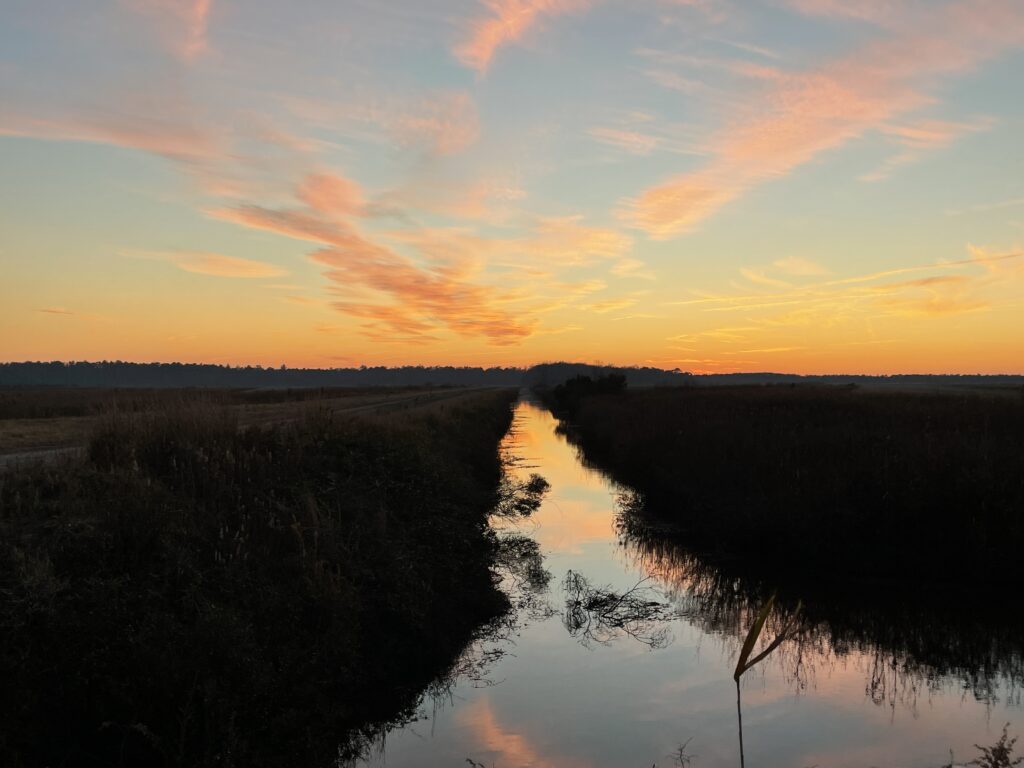
Alligator River National Wildlife Refuge
In the early days of the reintroduction program, conservationists and biologists chose the Alligator River National Wildlife Refuge – part of North Carolina’s Inner Banks – to focus on red wolf recovery efforts. The refuge is surrounded by water on three sides, providing a geographic buffer and offering large amounts of public land with the resources needed for wolf survival.
North Carolina Wildlife Federation has a long history with red wolf education, outreach and reintroduction. We partner with federal and state agencies, landowners and other conservation NGOs to address challenges facing red wolves in the wild and restore the species.
NCWF collaborated with USFWS’s Partners for the Fish and Wildlife to design and launch Prey for the Pack, a cost-share program that provides technical and financial support to private landowners to help create and improve habitat for red wolves and other wildlife. We also assist USFWS and the Coastal Wildlife Refuge Society to properly manage fire breaks on Pocosin Lakes National Wildlife Refuge to reduce potential wildfire devastation and increase early succession habitat.
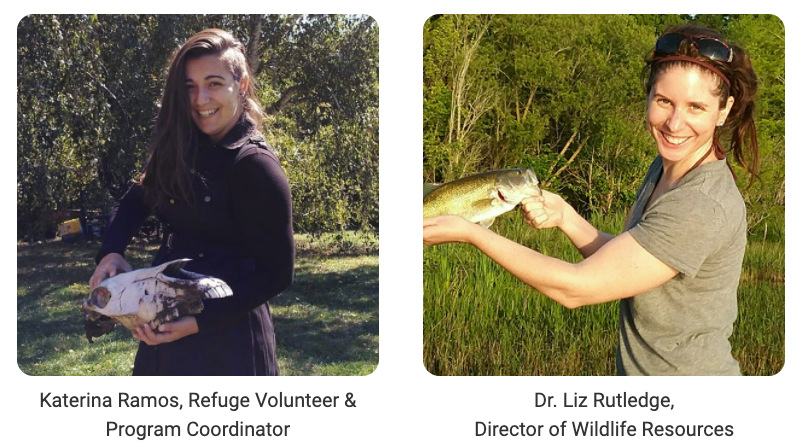
We chatted recently with Dr. Liz Rutledge and Katerina (Kat) Ramos about NCWF’s red wolf education and outreach efforts. In her role as Director of Wildlife Resources, Dr. Rutledge applies science-based decision-making and policy to NCWF’s on-the-ground conservation and management programs.
Kat is our Refuge Volunteer and Programs Coordinator at the Red Wolf Center, part of Pocosin Lakes National Wildlife Refuge in Columbia. The center provides a centralized location within the recovery area where the public can receive up-to-date information on wild red wolves, attend weekly educational talks and view two captive red wolves.
NCWF: What’s so special about red wolves?
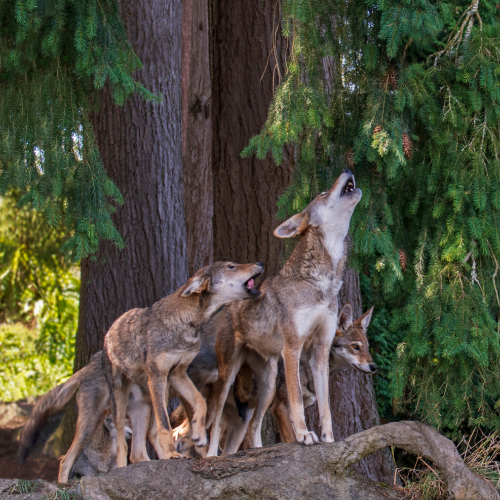
Red wolf pups can begin howling at three weeks old.
Liz & Kat: North Carolina is the only place in the world where a wild population of red wolves exists, which is something North Carolinians should be proud of and cherish. Red wolf pups can begin howling at three weeks old. There was a time when these awe-inspiring calls were more common in our state, and it would be amazing to go outside and hear the howl of the red wolf again. They’re also unique in that red wolves live in a pack similar to a family unit. Their packs tend to be smaller than those of gray wolves and usually consist of a dominant breeding pair and offspring. Once the offspring are old enough, they typically break off, find a mate and create their own packs. Many people believe ecotourism opportunities could provide an economic boost throughout the red wolf recovery area and help put North Carolina’s Inner Banks on the map as the “Yellowstone of the East.”
NCWF: What can visitors expect to see and experience at the Red Wolf Center?
Liz & Kat: Though you may not see a wild red wolf outside of eastern North Carolina for quite some time, you can still see them in captivity. The center’s biggest draw is the outdoor enclosure that houses a pair of red wolves, a 13-year-old male and a 7-year-old female. From the public viewing area, visitors have the rare opportunity to observe red wolves and their behavior up-close and personal. Visitors can see mounted specimens in our educational building, including two coyotes, three red wolves and a gray wolf. Viewing the mounts side-by-side gives visitors a chance to compare species and helps display what makes red wolves unique from their other canine relatives.
We’ve also installed cameras in the wolf den and enclosure so people from around the world can experience these unique animals, even if they’re unable to visit the Red Wolf Center in person. Viewers will observe the wolves moving about the enclosure, interacting with one another, snoozing, sniffing out and eating the food that caretakers place around the enclosure, and maybe even hear some howling. The cameras will also help staff and caretakers observe the wolves from a distance to continue learning about their behavior and needs.
NCWF: What role do red wolves play within the ecosystem?
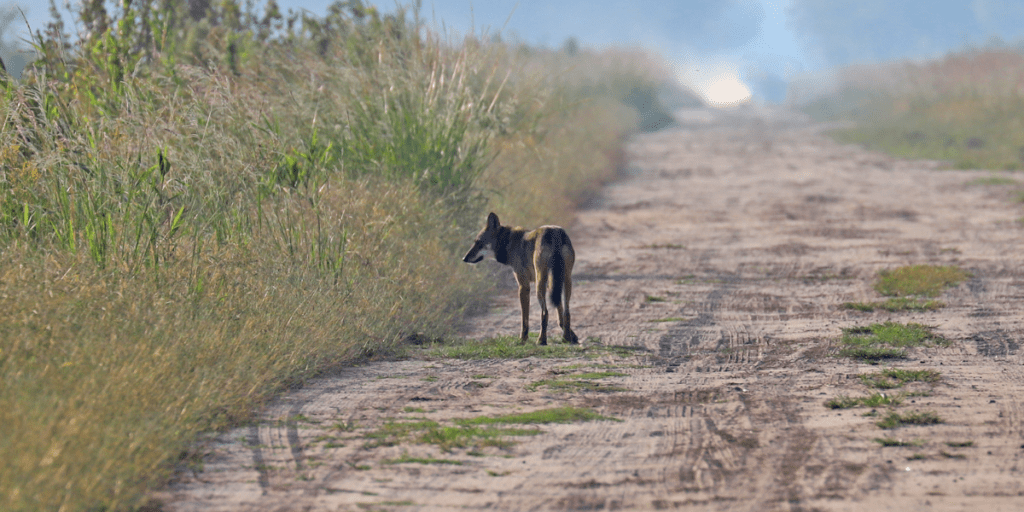
Red wolves have distinct reddish coloration along their body and legs and have noticeably longer legs and larger feet than other canids.
Liz & Kat: Everything is connected in an ecosystem, and having a top predator on the landscape such as a red wolf can help maintain balance. They help manage healthy prey populations by removing sick, old or injured individuals. Healthy animals have a higher chance of escaping predation, which allows them to continue reproducing. In some cases, predation on invasive species can protect habitat and native species. In North Carolina, red wolves prey upon nutria, an invasive rodent that can damage wetland systems. Ground nesting birds may also benefit from the presence of larger apex predators like wolves, as their diet may include mesopredators like raccoons that are known to raid nests for eggs and juvenile birds.
NCWF: Are red wolves and coyotes the same species?
Liz & Kat: Some believe coyotes and red wolves are the same because they can hybridize; however, a 2018 Species Status Assessment identified the red wolf as its own distinct species. While red wolves were originally considered a subspecies of the gray wolf, further research using genetic, morphological, paleontological and other data showed the red wolves evolved from a common ancestor with the coyote and are separate from gray wolves.
Red wolves have distinct reddish coloration along their body and legs and have noticeably longer legs and larger feet than other canids. They typically weigh between 45 and 80 pounds, whereas coyotes weigh about 40 pounds. On the landscape, it’s easy to confuse the two, but on a physical and genetic level, they are distinct species. USFWS uses bright orange collars on red wolves to help hunters and landowners differentiate between the two and reduce accidental wolf mortality from gunshots.
NCWF: How does coyote sterilization fit into the recovery program?
Liz & Kat: Coyotes aren’t native to North Carolina; they’re native west of the Mississippi River. In addition to expanding their range eastward over the last few decades, they were illegally released in North Carolina for sport hunting. Coyotes are now common throughout our state, including urban areas, and one of the biggest setbacks of the red wolf recovery efforts is hybridization. Red wolves will breed with coyotes out of desperation when they cannot find another red wolf mate. In addition to the hybridization, coyote populations tend to grow faster than red wolves, leading to large numbers of coyotes. Coyote sterilization isn’t a spay and neuter process like domestic pets. They are left hormonally intact, so they still have the behaviors needed to defend territory. This prevents other coyotes from moving into their territory and reduces the chances of coyote litters or hybrid pups being born. This sterilization technique gives the best of both worlds – fewer coyotes being born and the best chance to continue increasing the red wolf population to eventually displace coyotes on the landscape.
NCWF: How does the recovery program address wildlife and vehicle collisions?
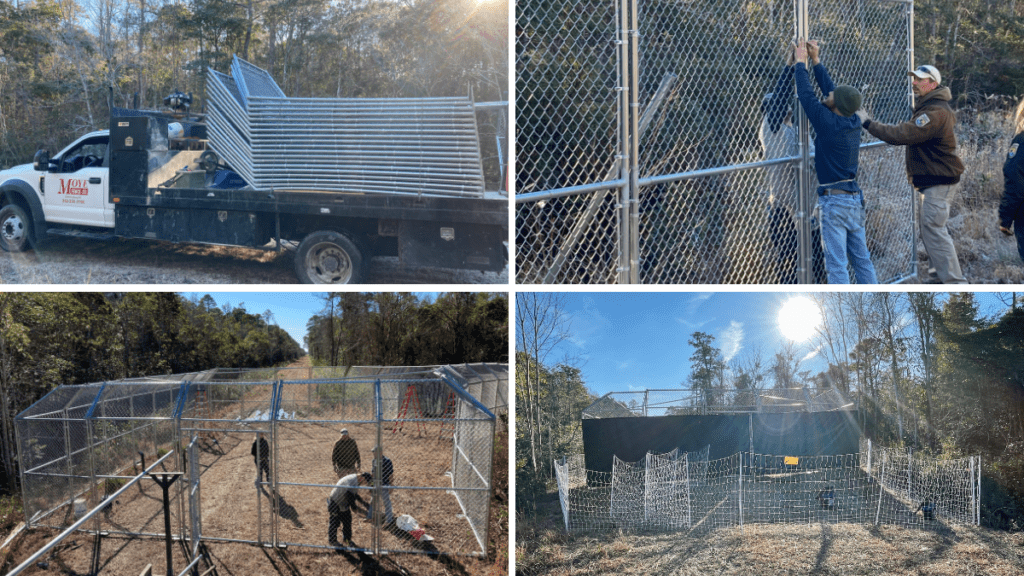
Loti Woods and Dale Weiler of Weiler Woods for Wildlife helped fund an acclimation pen for the Red Wolf Recovery Program.
Liz & Kat: To prepare for the 2022 red wolf release season, NCWF and USFWS purchased and installed four electronic message boards to alert drivers there may be red wolves (and other wildlife) crossing in the area. We hope the boards will help reduce vehicle-wolf mortalities as future wolf releases occur. Also this year, Loti Woods and Dale Weiler of Weiler Woods for Wildlife helped NCWF purchase an electrified bear-proof acclimation pen for the Red Wolf Recovery Program. The pen, which will be taken down and moved to different locations for future releases, provides a low-stress holding place for red wolves before they are released into the wild.
NCWF: What are some other challenges with red wolf conservation and recovery?
Liz & Kat: Because many people are still unaware that wolves exist in the wild in North Carolina, we must continue creating general awareness of the species and provide historical and biological education. Additionally, red wolves are highly misunderstood. Some people worry about co-existing with them, fear for the safety of their livestock or pets, or believe red wolves will reduce the white-tail deer population. However, red wolves are naturally shy, elusive and wary of people, making wolf-human interactions rare.
Over the last 30 years, there have only been eight documented cases of red wolves disturbing or preying on livestock and no cases of a red wolf injuring a human. And while white-tail deer are part of their diet, a research project conducted by Chief Scientist Ron Sutherland with Wildlands Network showed deer harvest increases when there are more red wolves on the landscape. The study also found the deer population is abundant and thriving both in the presence and absence of red wolves.
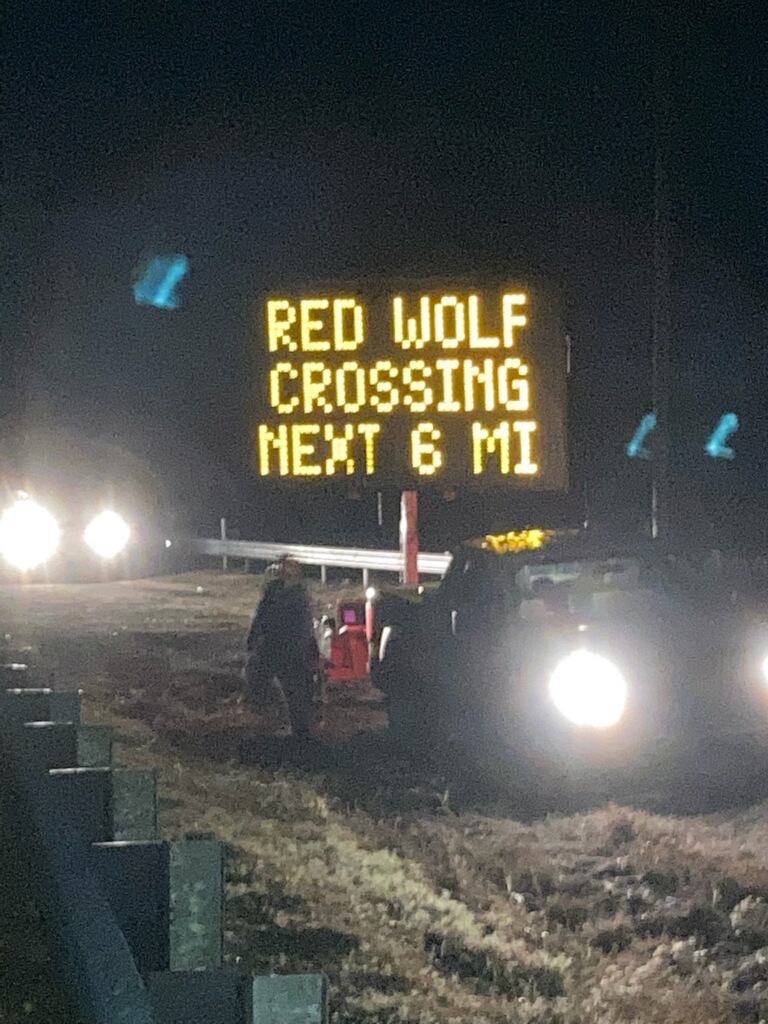
Electronic message boards on the Albemarle-Pamlico Peninsula alert drivers there may be red wolves crossing.
Ways to support red wolves and other wildlife
Species recovery requires resources and effort, and it will take all of us to ensure red wolves endure for generations to come. Here’s how you can help.
- Join the Prey for Pack habitat improvement program to support wildlife while meeting land management goals. Enrollment is open to landowners who live in the current recovery area of wild red wolves (Beaufort, Dare, Hyde, Tyrell and Washington counties).
- If you live on the Albemarle-Pamlico Peninsula, become a citizen scientist by installing a trail cam to capture wildlife footage on your property and share your findings with us.
- Educate yourself and others about red wolves and their habitat, and stay actively engaged in the population’s current status
- Advocate for the species by letting the Governor, State Senators and State Representatives know you support red wolves in North Carolina.
- Sign up to receive news, information, events and opportunities to take action for wildlife and their habitats in North Carolina.
- Donate to protect, conserve and restore red wolves and other wildlife and habitat in North Carolina wildlife.
Call the USFWS red wolf recovery helpline for questions about the program at 1-855-4-Wolves (1-855-496-5837).

